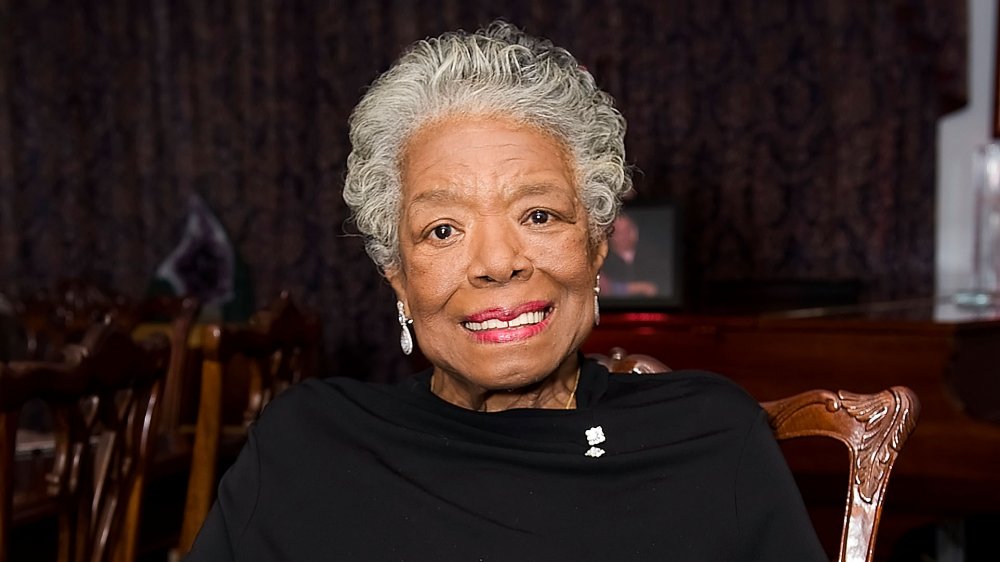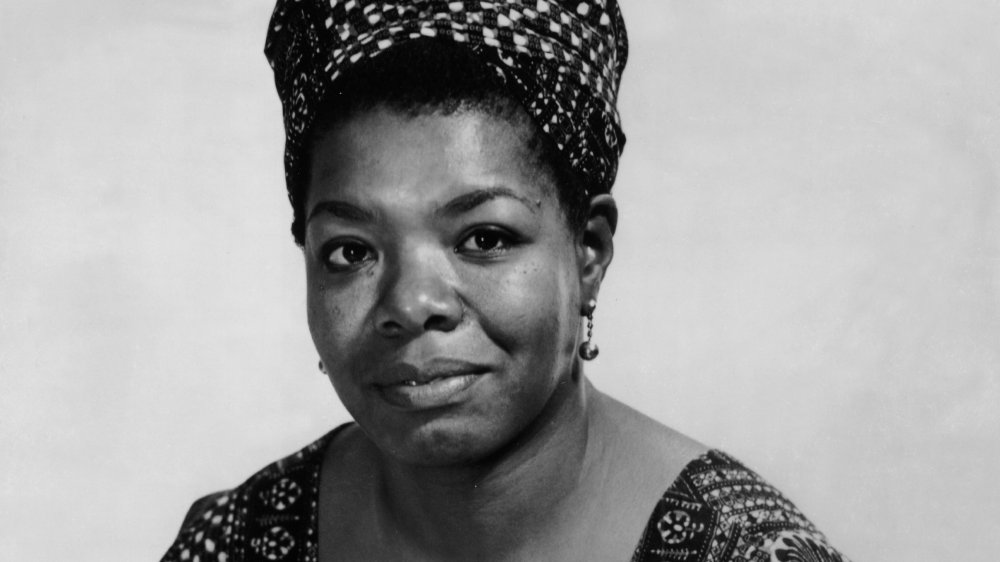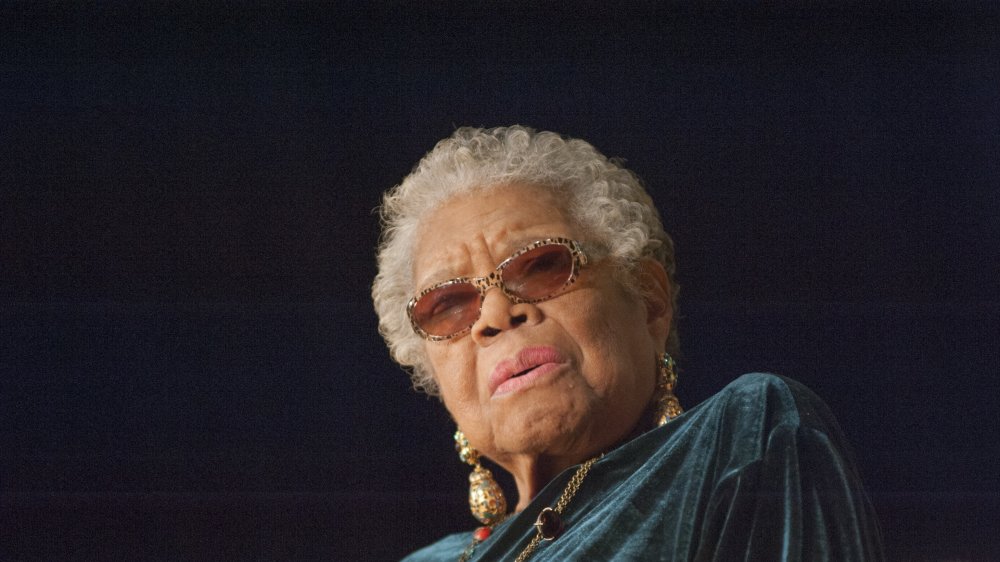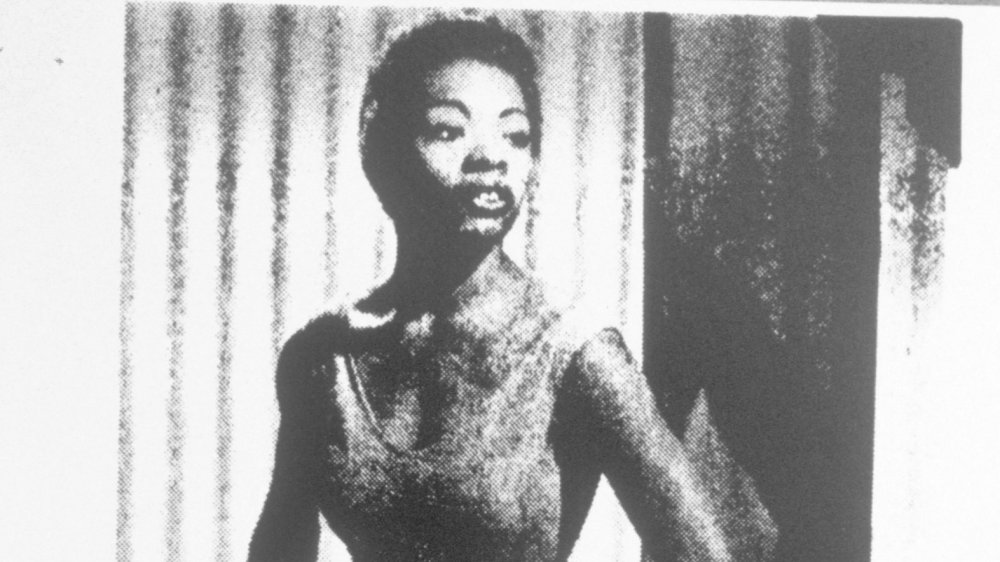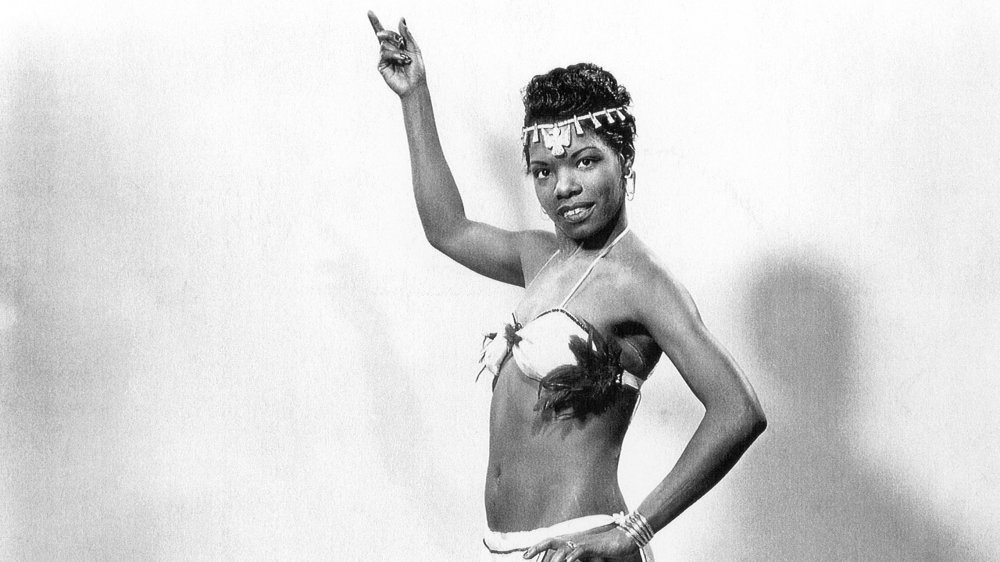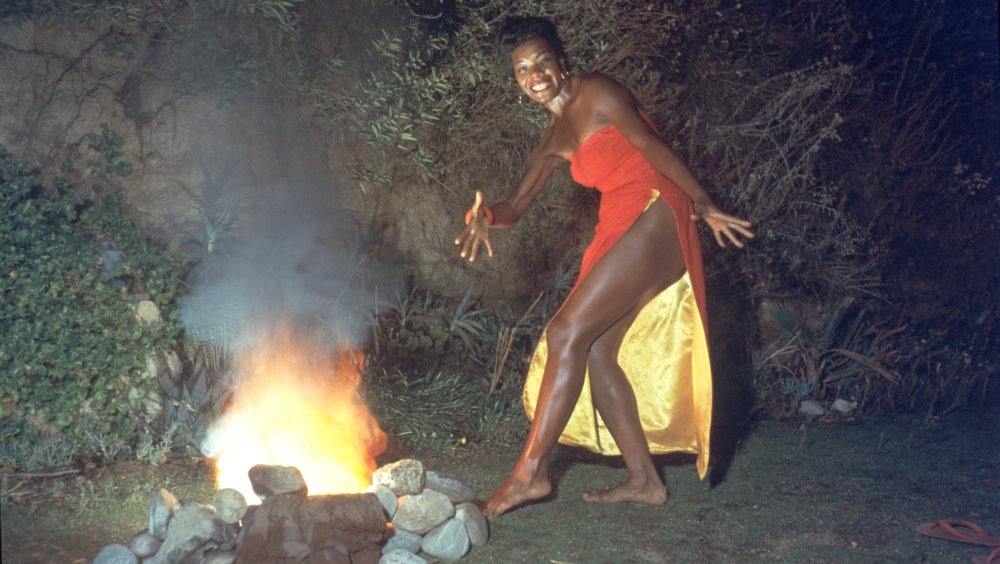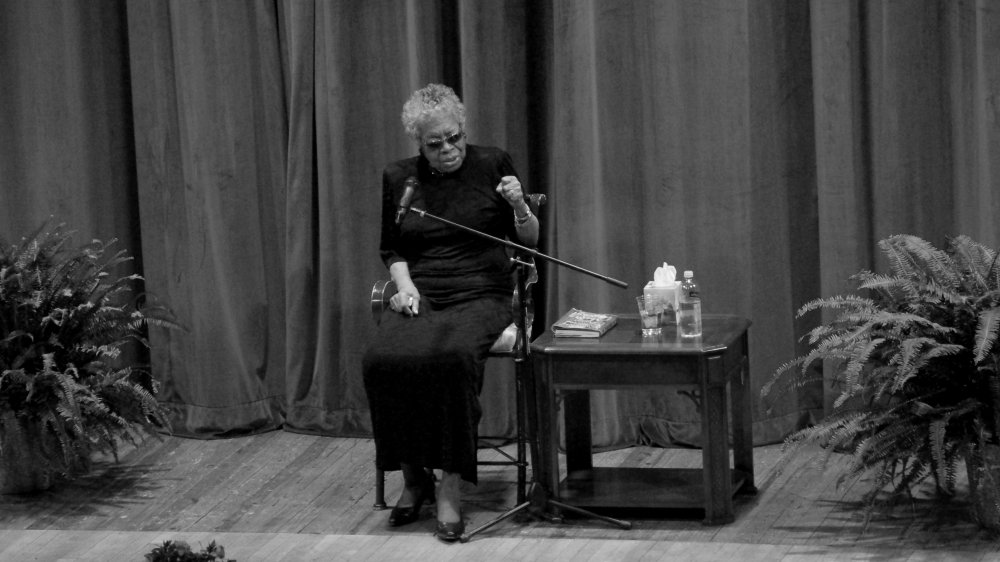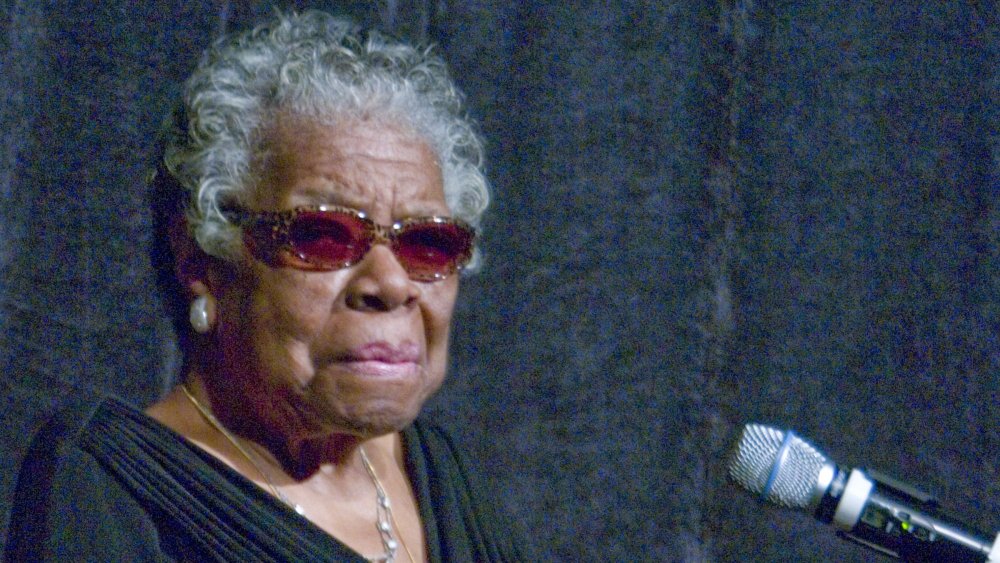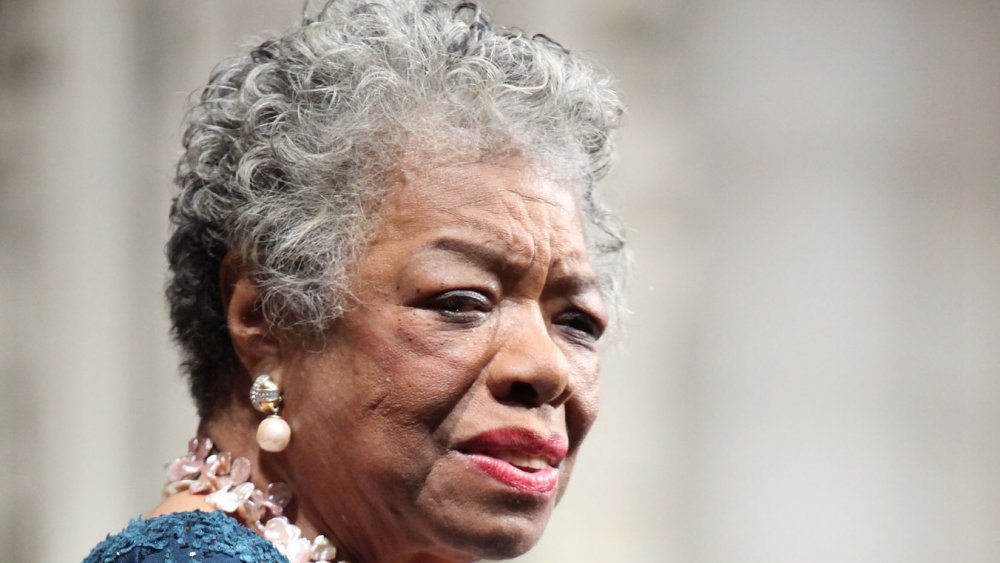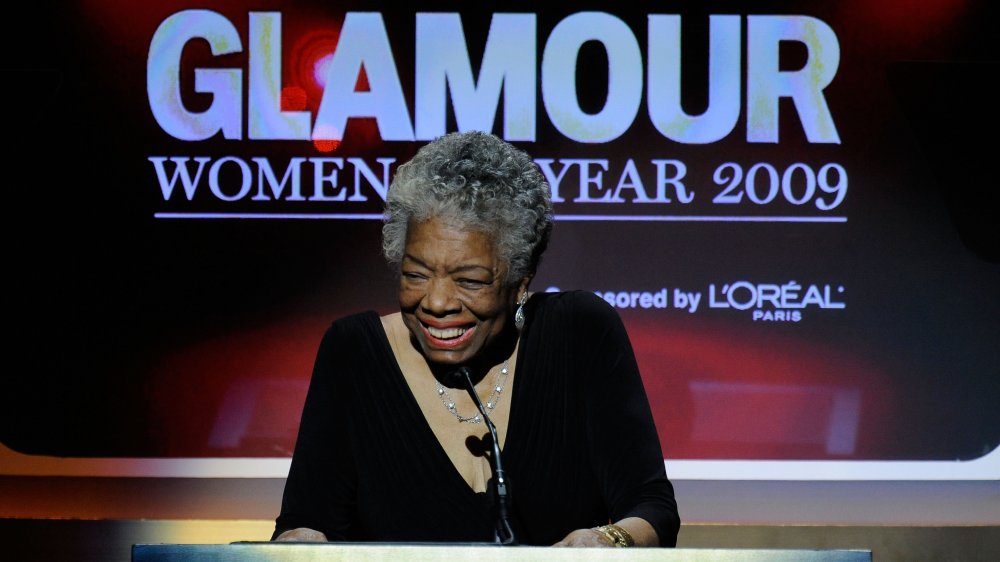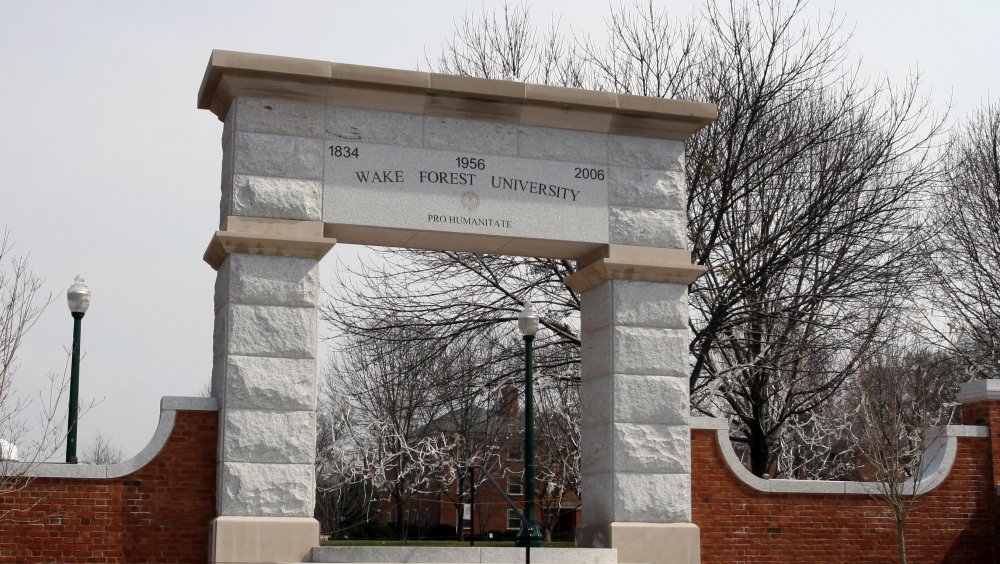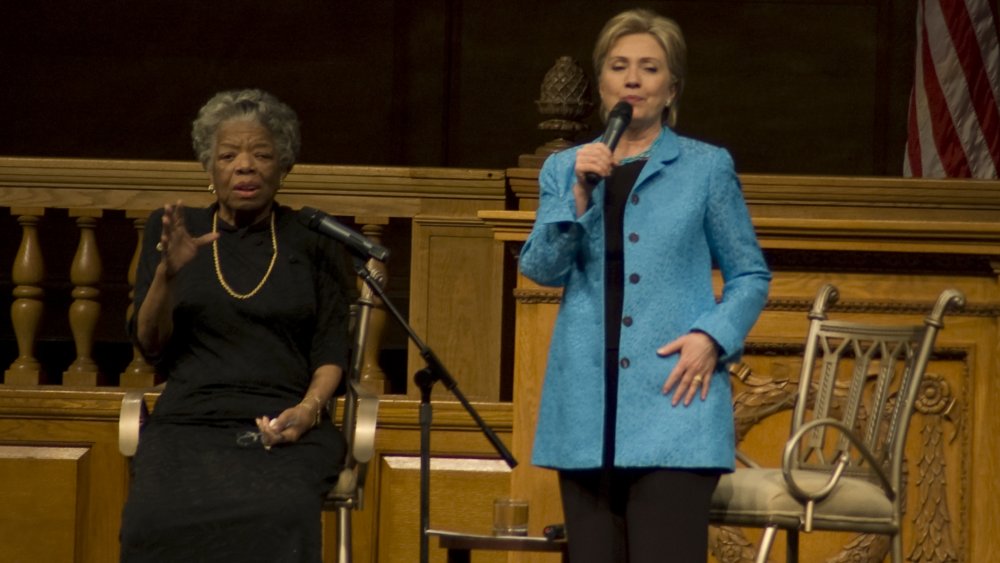The Tragic Real-Life Story Of Maya Angelou
Maya Angelou once said: "I realized when I was about 20 that I would die. [...] It so terrified me that I doublelocked the doors [...] trying to keep death out — and finally I admitted that there was nothing I could do about it. Once I really came to that conclusion, I started enjoying life, and I enjoy it very much," via Smithsonian Magazine. Angelou's rich enjoyment of all of life's offerings have led her to earn a Tony Award nomination, three Grammy Awards, an Emmy, the National Medal of Arts, the Lincoln Medal, and an induction into the National Women's Hall of Fame, among other honors, according to The History Makers.
While her work had long been admired by many for years, her recognition among the general public skyrocketed after she became the second poet in history to recite a poem at a presidential inauguration. In 1993, she read "On the Pulse of Morning" at Bill Clinton's inauguration, and her fame broadened as even more people began seeking out and appreciating her work. Maya Angelou has become one the most influential and popular authors in American history, and she overcame more than her fair share of hardships to do so.
Maya Angelou was raised by her grandmother
Maya Angelou was born Marguerite Annie Johnson in St. Louis, Missouri, on April 4, 1928, according to Britannica. Her mother, Vivian Baxter, a beautiful and sophisticated St. Louis native, fell in love with Bailey Johnson, Angelou's father, in 1924, shortly after he returned from serving in the Navy.
When Angelou was still a baby, her parents moved west, hoping to escape the racism of the South and Vivian's disapproving family. However, in California, their marriage quickly turned rocky, and they separated when Angelou was three. She and her five-year-old brother, Bailey, were sent to live with her paternal grandmother, Annie Henderson, in Stamps, Arkansas, per The Guardian. "They put me and my brother on a train, without any companionship, without any adult, put tags on our arms, and said, 'This child should be delivered to Miss Annie Henderson in Stamps, Ark,'" Angelou recalled, via NPR. At first, she thought that they had done a "terrible thing" to herself and her brother, but later in her life, Angelou said she would "thank God [...] I was sent to my paternal grandmother," via Smithsonian Magazine.
Annie Henderson, with her other son, Angelou's Uncle Willie, owned and operated the local general store. She was a sharp businesswoman and a loving grandmother. Angelou greatly admired her grandmother, saying, "She gave me so many gifts," including "confidence that I was loved." Stamps, Arkansas, proved to be a relatively safe haven for the early years of Angelou's life.
My voice was a killing machine
Angelou returned to St. Louis just once to visit, when she was not quite eight years old. While she was staying with her mother, Vivian's boyfriend, a man named Freeman, raped Angelou. She told her brothers, who then told the rest of her family. Freeman was arrested and found guilty but served only one day in jail for the crime.
Just four days after Freeman was released, however, Angelou's uncles beat him to death in retaliation. After the assault and subsequent killing, Angelou refused to speak for five years. She believed that her voice had directly led to the man's death, saying: "My mother and her family tried to woo me away from mutism, but they didn't know what I knew: that my voice was a killing machine," via The Guardian.
Angelou told Smithsonian Magazine that she credited this time for spurring her love for language: "I believe that my brain reconstructed itself during those years. I believe that the areas in the brain which provide and promote physical speech had nothing to do. [...] And so, I've been able to develop a memory quite unusual, which has allowed me to learn languages, really quite a few." While she did not speak, she immersed herself in the words of literary greats like Shakespeare, W.E.B. Du Bois, and Edgar Allan Poe, and memorized all the poetry she could find, including the works of Langston Hughes and Paul Lawrence Dunbar.
Maya Angelou was San Francisco's first African-American female cable car conductor
When Angelou was 14 and her brother Bailey was 16, her grandmother decided "he had reached a dangerous age for a black boy in the segregated south," according to The Guardian. She decided it was time to send them both back to live with their mother, who had since moved to Oakland, California.
In 1942, Angelou began attending the California Labor School in San Francisco, where she studied acting and dance on a scholarship, per Biography. To earn extra money while studying, she decided she wanted to work as a cable car conductor, because she "loved the uniforms," according to Time. The Market Street Railway Company initially refused to hire her because of the color of her skin, but she was determined. She showed up to the company every morning and sat there reading books until management finally relented and offered her the job. At just 16 years old, she became San Francisco's first female African-American cable car conductor.
Also that year, she became pregnant after having sex to prove she wasn't a lesbian, per Boston.com. Upon telling her mother about the pregnancy, Angelou later recounted: "She asked me, 'Do you love the boy?' I said no. 'Does he love you?' I said no. 'Well, there's no point in ruining three lives. We're going to have us a baby,'" via Smithsonian Magazine. Angelou gave birth to her only son, Guy Johnson, just one month after her high school graduation.
Maya Angelou briefly worked in a brothel
With a new baby to care for, Angelou moved out of her mother's house at just 17 years old. She found a room for rent in San Francisco, where the landlady agreed to babysit her son while she worked odd jobs to support them. In her autobiography, Angelou recalled some of the jobs she held in that time, including "a shake dancer in night clubs, fry cook in hamburger joints, dinner cook in a Creole restaurant and once had a job in a mechanic's shop, taking the paint off cars with my hands," via Poetry Foundation.
In her late teens, she began a relationship with an older man named L.D., who was married and had a gambling problem. After losing over $5,000, he convinced Angelou to work in a brothel to make enough extra money to pay back his gambling debt. Believing they would get married once they had enough cash, Angelou agreed, and for a short time, she worked as a sex worker and madam. While some critics have pointed out that this era of Angelou's life is frequently glossed over or left out in her later biographies, Angelou herself was quite open about her time as a sex worker, recounting the experience her 1974 memoir Gather Together in my Name: "The faces, bodies and smells of the tricks made an unending paisley pattern in my mind. [...] The strong Lysol washing water stung my eyes and a film of vapor coated my adenoids," via archive.org.
Maya Angelou had a successful dance career
In the 1950s, Angelou turned her attention to her dance career and began performing in clubs around San Francisco. She also took modern dance classes, studying under influential choreographers like Martha Graham. While taking classes, she met famed dancer Alvin Ailey. The pair teamed up for a short time, dancing together as "Al and Rita," but their act never took off.
Angelou moved to New York City to study African dance for one year under the choreographer Pearl Primus, before returning to San Francisco and making a name for herself performing cabaret and dancing calypso at the Purple Onion, a nightclub often frequented by talent scouts, according to Poetry Foundation. At the Purple Onion, she officially took on the stage name "Maya Angelou," combining her childhood nickname with the last name of her former husband.
The newly christened Maya Angelou's stage career started to take off. From 1954 to 1955, she toured throughout Europe and Africa with a production of Porgy and Bess. After returning to America, she performed in the off-Broadway show Calypso Heat Wave and later in the play The Blacks. Angelou also began recording her calypso music performances, releasing her first album of calypso music, titled Miss Calypso, in 1957, per Biography.
Come find out if you really are a writer
While Angelou was performing in clubs around California, she met many influential artists and writers, including Langston Hughes and novelist John Oliver Killens. In 1959, Killens suggested she should move to New York permanently and "come find out if you really are a writer," as reported by The Guardian. Angelou, who later described herself as "young enough and silly enough" to take him up on his offer, moved to New York City and began publishing her first pieces of writing.
Angelou joined the Harlem Writers Guild, where she befriended many other important writers of the time, including James Baldwin, who she would affectionately call her "brother friend," per Timeline. Baldwin, along with editor Robert Loomis, would go on to encourage Angelou to write an autobiography. Although she was reluctant at first, she eventually decided to try her hand at memoir-writing, and the result was her acclaimed 1969 autobiography I Know Why the Caged Bird Sings, according to Poetry Foundation.
Maya Angelou mourned both Martin Luther King Jr. and Malcolm X
It was also in New York where Angelou became actively engaged with the civil rights movement. After hearing Martin Luther King Jr. speak in Harlem, Angelou began immersing herself in the fight for racial equality, using her remarkable writing talents to raise funds for the Southern Christian Leadership Conference. Angelou, with actors Godfrey MacArthur Cambridge and Hugh Hurd, wrote and co-produced a "Cabaret for Freedom." The show raised so much money that Angelou was appointed the new director of SCLC's New York office, per The Nation, where she worked closely with King to organize and raise funds. Although she was living in Ghana during King's historic March on Washington for Jobs and Freedom in 1963, she still participated, marching outside the American Embassy in Accra in solidarity.
While in Africa, Angelou became close with another expatriate living in Ghana: civil rights leader Malcolm X. Together, they formed the Organization of African American Unity in 1964, according to The History Makers. When Malcolm X was assassinated the following year, the organization fell apart and Angelou, grieving the loss of her friend, spent the next year living in Hawaii.
Angelou returned to New York in 1967, but in a tragic twist of fate, King was assassinated on Angelou's 40th birthday, just as she was getting ready to go on a nationwide tour promoting King's Poor People's Campaign. Devastated after the deaths of Malcolm X and King in such short succession, Angelou channeled her energy even more intensely into her writing.
Maya Angelou's son almost died
Angelou moved to Africa in the midst of the civil rights movement. In 1961, she began dating a South African freedom fighter named Vusumzi Make. The couple, along with Angelou's son, moved to Cairo, Egypt, to continue the fight against apartheid. While living in Egypt, Angelou wrote for a weekly radical newspaper called The Arab Observer, according to The History Makers.
After the relationship ended in 1962, Angelou decide to move to Ghana, where her son planned to attend college. However, just three days into their arrival in the country, he broke his neck in a car accident, per the Los Angeles Times. He made a remarkable recovery and was able to go on to attend college, while Angelou began working for the magazine The African Review as a features editor.
Angelou continued fighting for civil rights even while living abroad, immersing herself in the African-American expatriate community there. She became close with activists and writers like W.E.B. DuBois, William Gardner Smith, and Julian Mayfield, per Africa Is a Country. Somehow, Angelou also found time to teach at the University of Ghana's School of Music and Drama and do freelance work for the Ghanaian Times and Radio Ghana. After another romantic relationship ended in infidelity, Angelou returned to the United States to work with Malcolm X in 1965.
Maya Angelou had a groundbreaking film and TV career
While Maya Angelou might be best known as a poet and influential memoirist, she was also had a groundbreaking career in film and TV. She wrote the screenplay and soundtrack for the drama Georgia, Georgia in 1972 and became the first African-American woman to have a screenplay produced, according to Poetry Foundation. Shortly after, she became one of the first African-American women to join the Directors Guild of America, according to Time.
Angelou went on to adapt her famous autobiography I Know Why the Caged Bird Sings for television, and the TV movie aired in 1979. She continued to expand her TV career, going on to have a supporting role in television miniseries Roots, for which she won an Emmy. Angelou had further roles in movies like Poetic Justice and How to Make an American Quilt in the 1990s, according to Britannica. In 1998, Angelou went behind the camera, making her directorial debut with the coming-of-age drama Down in the Delta at 70 years old. Never one to let age slow her down, she continued to act well into her seventies. Her final role on screen was as the character May in Tyler Perry's 2006 comedy film Madea's Family Reunion, per IndieWire.
Maya Angelou's only grandson was kidnapped
In 1981, tragedy struck Maya Angelou's family. Angelou had one grandson, Colin Ashanti Johnson, with whom her son, Guy Johnson, shared custody rights with his ex-wife. Sharon Murphy, Colin's mother, had visitation rights once a month. On April 13, 1981, she arrived to pick up her son, as usual. But the following Sunday, she never brought Colin home.
For the next four years, Johnson and Angelou would have no contact with Colin, and there were no leads. The stress took a toll on Johnson's health, aggravating his old neck injury so badly that he was briefly paralyzed from the neck down. Calcium deposits and blood clots had weakened his spine so badly that he was unable to walk, and he had to undergo multiple surgeries. Johnson, however, was determined to make a full recovery and see his son again, declaring, "When I have my son back, I want him to see me fine," via the Los Angeles Times.
Angelou and Johnson never stopped searching, spending thousands of dollars investigating the disappearance. On May 29, 1985, they caught a break when an acquaintance of Murphy's contacted Angelou, giving her Murphy and Colin's location in Austin, Texas. Angelou contacted the authorities, and Murphy eventually agreed to meet. The arranged meeting took place at the home of Angelou's attorney in Austin, and on June 6, 1985, over four years after she'd last laid eyes on him, Angelou was finally able to bring her grandson home.
Face the fear/loathing at its source
In 1973, Maya Angelou returned to the South for the first time since her childhood to speak at Wake Forest University in Winston-Salem, North Carolina. She had refused to return to the South for most of her life, saying, "I knew my heart would break if ever I put my foot down on that soil, moist, still, with old hurts," via Ebony. However, eventually, she "began to realize how severely The South was obsessing me," and Angelou realized she needed to "face the fear/loathing at its source or it would consume me whole."
In 1981, she was offered the Reynolds Professorship of American Studies at Wake Forest, and she accepted. When she first arrived, she was one of only a few African-American professors on staff. But she was wanted to "find friends, join a church, and add my energy to the positive movement to make this country more than it is today," and she certainly did so. In 2008, Angelou declared: "I'm not a writer who teaches. I'm a teacher who writes. But I had to work at Wake Forest to know that," via Wake Forest University.
Having found yet another fulfilling calling, Angelou was an active part of the Wake Forest academic community, teaching courses on a variety of subjects, including "World Poetry in Dramatic Performance," "African Culture and Impact on U.S.," and "Shakespeare and the Human Condition." She continued teaching and lecturing at Wake Forest until her death at age 86.
I've never been bored in my life
Maya Angelou once remarked in an interview: "I see myself as a very interested person. I've never been bored in my life," via Smithsonian Magazine. With all she accomplished in her lifetime, it's impossible to see how she could have found time to be bored. Regardless of the troubles she'd faced in her life, Angelou remained impressively productive, writing seven autobiographies and publishing the final volume in 2013, at the age of 85.
In addition to teaching and writing, Angelou remained politically and socially active, campaigning for Hillary Clinton in the 2008 Democratic primary and Barack Obama in the general election.
In 2010, Angelou donated her personal papers and memorabilia to the New York Public Library's Schomburg Center for Research in Black Culture in Harlem, saying, "I have always wanted my papers to be at the Schomburg. [...] It's a magnificent depository of all the information about the African-American experience. I am grateful that it exists so that all the children, Black and White, Asian, Spanish-speaking, Native Americans and Aleutian can know there is a place where they can go and find the truth of the people's history," via Jet. Maya Angelou died May 28, 2014, but her legacy continues to inspire others through her impressive body of work.
